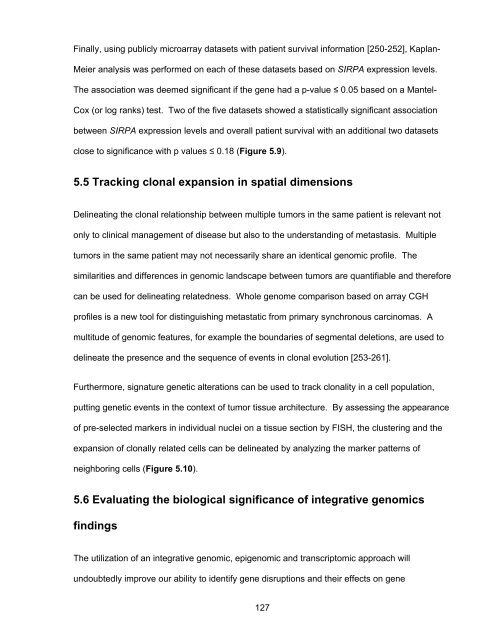Chapter 2 - University of British Columbia
Chapter 2 - University of British Columbia
Chapter 2 - University of British Columbia
You also want an ePaper? Increase the reach of your titles
YUMPU automatically turns print PDFs into web optimized ePapers that Google loves.
Finally, using publicly microarray datasets with patient survival information [250-252], Kaplan-<br />
Meier analysis was performed on each <strong>of</strong> these datasets based on SIRPA expression levels.<br />
The association was deemed significant if the gene had a p-value ≤ 0.05 based on a Mantel-<br />
Cox (or log ranks) test. Two <strong>of</strong> the five datasets showed a statistically significant association<br />
between SIRPA expression levels and overall patient survival with an additional two datasets<br />
close to significance with p values ≤ 0.18 (Figure 5.9).<br />
5.5 Tracking clonal expansion in spatial dimensions<br />
Delineating the clonal relationship between multiple tumors in the same patient is relevant not<br />
only to clinical management <strong>of</strong> disease but also to the understanding <strong>of</strong> metastasis. Multiple<br />
tumors in the same patient may not necessarily share an identical genomic pr<strong>of</strong>ile. The<br />
similarities and differences in genomic landscape between tumors are quantifiable and therefore<br />
can be used for delineating relatedness. Whole genome comparison based on array CGH<br />
pr<strong>of</strong>iles is a new tool for distinguishing metastatic from primary synchronous carcinomas. A<br />
multitude <strong>of</strong> genomic features, for example the boundaries <strong>of</strong> segmental deletions, are used to<br />
delineate the presence and the sequence <strong>of</strong> events in clonal evolution [253-261].<br />
Furthermore, signature genetic alterations can be used to track clonality in a cell population,<br />
putting genetic events in the context <strong>of</strong> tumor tissue architecture. By assessing the appearance<br />
<strong>of</strong> pre-selected markers in individual nuclei on a tissue section by FISH, the clustering and the<br />
expansion <strong>of</strong> clonally related cells can be delineated by analyzing the marker patterns <strong>of</strong><br />
neighboring cells (Figure 5.10).<br />
5.6 Evaluating the biological significance <strong>of</strong> integrative genomics<br />
findings<br />
The utilization <strong>of</strong> an integrative genomic, epigenomic and transcriptomic approach will<br />
undoubtedly improve our ability to identify gene disruptions and their effects on gene<br />
127

















